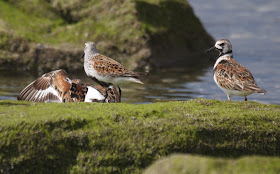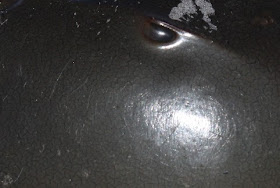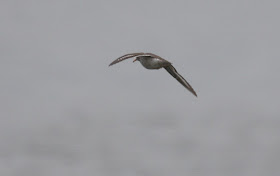Here are a few Highlights:
Hammonasset Beach SP, May 21- I made a quick stop in the Park since I was in the area (had to make a quick run to West Marine for epoxy). There wasn't much around, but this single Short-billed Dowitcher (one of my top favorite Shorebird species) was feeding in Meigs Pond.......
........until the Willet came and chased it off; but it only flew a few yards away!
After a few days of rain, and more rain being forecasted for Thursday, I woke up and discovered a beautiful sunrise! A quick check of the weather showed that rain was still in the forecast but that sun was too inviting! I decided to try for a few hours of Shorebirding, hopefully the rain would hold.....and it did!
Milford Point, from 8:00 am to 10:30 am- The tide was very low with the flats well exposed all the way to the high stones. The steamer clam flats near the low stones on Pompey's Bar (a name we called it because we used to dig steamer clams there many, many years ago)...in fact there are so many soft-shelled clams there you will actually get soaking wet from the clam spouts as you walk over the flats!
(From a very respectible and safe distance) the two Piping Plover could be seen sitting on their nests safely within the security enclosures. Thankfully with a long camera lens and the ability to zoom and crop the images, you can see and appreciate the birds in these images:
A little re-adjustment. The Plover turned the eggs and then settled in again. You can see the bird opening its breast and abdomen feathers exposing its "brooding patch"....if you look closely, you can see a white and black speckled egg underneath.
The second incubating bird- can you find it?
Here's a hint!
Besides the two incubating birds, there were five additional Piping Plovers on the sandbars and flats; I photographed each one:
There were five Oystercatchers on the bar/flats and high stones:
A few Snowy Egrets and an occassional Glossy Ibis-
The flats were quiet at first, with only a few scattered Least Sandpipers-
Then as if someone had turned on a switch; flocks of Shorebirds began arriving-
The flocks consisted of Black-bellied Plover, Ruddy Turnstone, Dunlin, Semi-palmated Plover and Sandpiper, Least Sandpiper, Short-billed Dowitcher and a few Red Knot.
Dunlin and Short-billed Dowitcher-
Dazzling Short-billed Dowitcher-
Stunning Dunlin-
Dunlin and Short-billed Dowitcher
Subtle Semi-palmated Sandpipers-
Only a few Sanderling-
On the high stones: Semi-palmated Sandpiper, Dunlin and Ruddy Turnstone-
One of the great joys in birding for adventure is that you can have many opportunities to experience other forms of wildlife other than birds. One that comes to the top of my mind is the breathtaking thrill of spouting and breaching whales while on a pelagic bird trip. The same can be true for a day walking on the beach watching Shorebirds.
It is well known about the relationship between the migrations of the Shorebirds and Horseshoe Crabs on the shores of Delaware Bay. The migrating Shorebirds time their migration perfectly with the arrival of the spawning Horseshoe Crabs as the Crabs deposit their eggs on the beaches, sandbars and mudflats. Although not as large an event here in New England, we do have the same scenario along a few areas of our shoreline, especially at Milford Point. Here is a great link regarding spawning Horseshoe Crabs:
The outer bars and flats were spattered with mating Horseshoe Crabs. Although many of the crabs were visible on the bar and flats, their tracks certainly told the story-
The Crabs were scattered and spread out all over the highest sections of the bar and flats. I walked carefully and photographed the Crabs closest to the perimeter of their area. Many were coupled........
(Close-up of the texture of the carapace)
.......and many were "digging-in" beginning the egg laying process.
But the most exciting was finding a tagged male Crab. The tag was incrusted with small barnacles so I couldn't read the number-
As I walked around, I found six more tagged male Crabs. I have already called in he numbers to the Maryland Dept. of Fish and Wildlife, and when I have the information about these Crabs, I will post it.
New Haven, Sandy Point, 11:15 am to 1:30 pm- I walked out on the low bar (with the buried pipe). There were Shorebirds everywhere: in the marsh, along the sandbar and flying up and down the Harbor. I missed the tide by about a half an hour: I wasn't able to crossover to the high bar. But there were plenty of Shorebrds to enjoy from the low bar. The highlights on the low bar: many Common and Least Terns, over five hundred Shorebirds including Least and Semi-palmated Sandpipers, Semi-palmated and Black-bellied Plover, Ruddy Turnstones, handfuls of Spotted Sandpipers in the grassy field along the path from the parking lot. Willets, and over one hundred Short-billed Dowitchers which included 1 Long-billed Dowitcher and at least two Red Knots.
Spotted Sandpipers in the marsh near the parking lot from the beginning of the path-
The pond in the middle between the two sandbars held many shorebirds, mostly Short-billed Dowitcher.
Semi-palmated Plover and Least Sandpipers-
Short-billed Dowitcher-
Incoming Semi-palmated Sandpiper and Black-bellied Plover
A Black-bellied Plover and a pair of Red Knot with the Short-billed Dowitcher
Ruddy Turnstones-
Black-bellied Plover-
Common Terns.......
The Shorebirds moved around constantly; from the marsh to the low sand bar where I was.
(A pair of Red Knot in the flock -above image and below)
Mixed flock with all the species mentioned (except Spotted Sandpiper and Willet)
Black-bellied Plover, Short-billed Dowitcher, Semi-palmated Sandpiper.......
......and Ruddy Turnstones.
Black-bellied Plover, Semi-palmated Sandpiper, Short-billed Dowitcher and Ruddy Turnstones-
Black-bellied Plover-
Black-bellied Plover with Short-billed Dowitcher
Short-billed Dowitchers, Black-bellied Plover, and Ruddy Turnstone with a single Red Knot in the back......
Mostly Short-billed Dowitcher-
I first spotted the Long-billed Dowitcher in my binoculars in the flock on a small sandy island across a small incoming tidal wash formed by the incoming tide. I wasn't able to get close enough for closer images. The bird featured the long narrow bill that didn't flare out at the basal line, gray chest, and its eye was located in a level eyeline by bill angle comparison in the center of its head. (See my earlier blog report:
I was able to take a few comparative long shots next to the surrounding Short-billed. The bird was slightly larger and taller, and is standing in a steep upright sleeping stance (compared to the slightly smaller Short-billed which displayed the usual nearly level sleeping stance). The bird still remained when I left, the rising tide forced me to retreat.
(The bird is located center-right in the small space-grayer in plumage)
Shorebirds came and went from the sandbar; some arriving from the southwest, and others leaving heading northeast into Long Wharf-
This pair of Red Knot flew by; I am not sure if it was the same two I photographed earlier, or another pair-
A Common Tern lands with a flock of Short-billed Dowitcher-
Black-bellied Plover with a Short-billed Dowitcher-
This Short-billed Dowitcher has a very long bill (probably a female)-
Least Tern pair-
An interesting sculpture??-
By now the tide had come up quite a bit so the inner marsh was starting to flood. Many of the Short-billed Dowitchers were feeding there (just in front of the parking area). This Willet joined a small flock of Short-billed Dowitchers-
The Spotted Sandpipers seemed top prefer the inner marsh-
On the way out I walked along a raccoon trail in the marsh and walked up on two Clapper Rail that were hunting Fiddler Crabs in the exposed areas along the edge-
Marsh Wrens were very active and vocal-
On this Memorial Day weekend 2012- God Bless and watch over our Brave Troops!
Keith Mueller
Killingworth, CT http://kmuellerart.blogspot.com/








































































































































































































